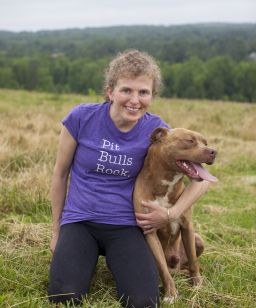Story highlights
Photographer Shannon Johnstone wants to help find homes for shelter dogs
She took photos of shelter dogs on a landfill that their bodies could end up in
Fortunately, of the 127 dogs she has photographed, 108 have gotten homes
Tails wagging wildly, tongues panting heavily, ears – soft as felt – flapping around as if they were wings propelling them against gravity.
These canines are getting some much-needed freedom from their leash, running, leaping and rolling on a field at a landfill in North Carolina.
But this is no normal walk in the park for these dogs, as it might be their last.
Homeless and ownerless, these shelter dogs have almost maxed their shelf life in the local pound, and they could end up in the landfill buried with everything else people have discarded.
This is the sad reality of a pet overpopulation problem that photographer Shannon Johnstone wishes to change through her wide lens and huge heart.

As a last-ditch effort to save these dogs from euthanasia, her “Landfill Dogs” project has already changed the metaphorical landscape: Of the 127 dogs she has photographed on these symbolic grounds, 108 have gotten homes.
But it’s more than just finding owners for the animals. She hopes to change the physical landscape as well and open the conversation about how to save these animals from a fate six feet under.
“Throwing bodies into landfill after being injected with a barbiturate isn’t good for the environment,” Johnstone said. “My hope is that underlying that, we can figure out what to do to curb overpopulation from starting in first place.”
Johnstone knew nothing about homeless dogs until she adopted one of her own after completing graduate school.
Her journey to shoot “Landfill Dogs” started with a forgotten crate and a neighbor nice enough to return it. The two spoke for a while about rescue animals and led Johnstone to start volunteering at the local shelter in Raleigh, North Carolina.
“I was awestruck by how many animals there were and how quick the turnover was,” Johnstone said.
The Wake County Animal Shelter houses animals as long as possible before they run out of room or resources to take care of them.
“The saddest thing is there is no alternative for animal overpopulation other than euthanasia, no other tool in their arsenal,” Johnstone said.
Her first project on the shelter in 2009, titled “Breeding Ignorance,” depicted the lethal injection process. She wanted to show people what happens when the animals are not adopted, and she wanted to show how hard the animal shelters work as “first responders” to “discarded property,” she said.
Years went by before she approached the subject again, but this time she took a different, more positive angle.
Instead of showing the “doom and gloom,” she wanted to show that animals could be helped out before it was too late.
The former director of the Wake County Animal Shelter asked her to come out to a landfill that he was turning into a public park.
She paused and thought, “Why is he involved in both waste and animals?”
The county animal shelter falls under the same management as the landfill. By law, pets are property.
“If you don’t want your property anymore, that’s what the animal shelter is for. And most of the time, they then end up in landfill,” she said.
Thus, “Landfill Dogs” was born to give man’s best friend the chance to be seen for their beauty – and to be saved, like the wasteland-turned-park that they play on.
Shannon Johnstone is an American photographer based in North Carolina. You can follow the “Landfill Dogs” project on Facebook.











